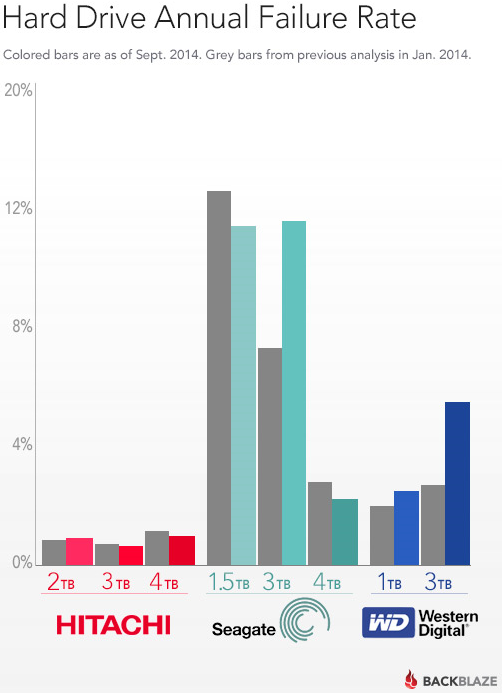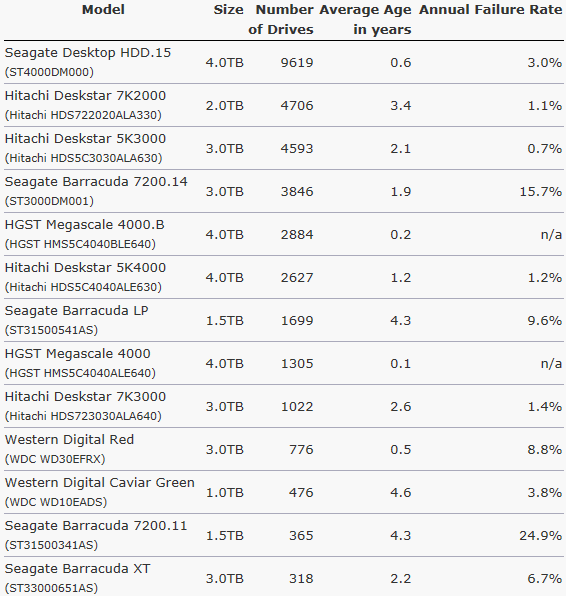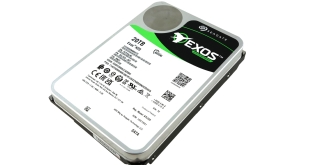Backblaze, a cloud-storage provider that uses consumer-class hard disk drives and extensive replication mechanisms to store data, has published a new hard drive reliability report. It is not a secret that many consumer-grade HDDs are not very reliable, but what is surprising and alarming is that failure rate of certain hard drives actually increases throughout their lifespan.
According to the new report from Backblaze, HGST (formerly Hitachi Global Storage Technologies) produces the world’s most reliable consumer-grade 2TB, 3TB and 4TB hard disk drives that fail in about 1 per cent of the cases per year. Seagate’s 4TB hard drives and Western Digital’s 1TB HDDs are also pretty reliable and have only 2 per cent annual failure rate. Unfortunately, there are drives from Seagate and WD that demonstrate rather extreme failure rates. Moreover, some drives get less reliable over time.
The alarming news is that Seagate’s 3TB drives now fail more often than they did in the past; their failure rate has jumped from 9 per cent to 15 per cent since January, Backblaze said. It should be noted that the company uses several versions of Seagate’s 3TB HDDs. The Barracuda 7200.14 has annual failure rate of 15.7 per cent, whereas the Barracuda XT has 6.7 per cent annual failure rate. The Seagate Desktop HDD.15 4TB seems to be more reliable than some other drives from the company. It fails in 3 per cent of cases per annum.
The Western Digital 3TB drives have also became less reliable at Backblaze. Failure rate of the WD 3TB drives went up from 4 per cent to 7 per cent, according to figures provided by the company.
Backblaze has 34881 hard disk drives and stores over 100 petabytes of data in its datacentre. The company uses only consumer-class HDDs and replicates data constantly. Backblaze monitors which consumer HDDs are reliable, and which ones need to be replaced. Since replacements cost money, the company tries to avoid failing hard drives. Still, even with 15 per cent annual failure rate it makes sense for Backblaze to continue using consumer-class hard disk drives instead of much more expensive enterprise-grade HDDs.
The table below shows the detailed breakdown of how many of which drives Backlaze has, how old they are on average, and what the failure rate is.
It should be noted that statistics from Backblaze reflects situation when consumer-class drives are used in datacentres. Consumer-class HDDs are designed for personal computers, not server and/or RAID environments.
Discuss on our Facebook page, HERE.
KitGuru Says: While the data here may not be completely reliable, it should be kept in mind when shopping for a new HDD.
 KitGuru KitGuru.net – Tech News | Hardware News | Hardware Reviews | IOS | Mobile | Gaming | Graphics Cards
KitGuru KitGuru.net – Tech News | Hardware News | Hardware Reviews | IOS | Mobile | Gaming | Graphics Cards





So basically, avoid 3TB and 1.5TB drives.
Or go with HGST when you need a hard drive with higher than average drive use.
Not this shit again, Backblaze is full of shit
http://www.tweaktown.com/articles/6028/dispelling-backblaze-s-hdd-reliability-myth-the-real-story-covered/index.html
But the general trend is correct where Seagate is worse , while WD is middle ground (about twice better in reliability) and HDS the best at twice better than WD. This was covered in a Google report I have seen a couple of years back where they surveyed way more than 10K disk of each type over the similar age range aggregate and the failure rate per year.
If you used a Seagate disk, you will realise how hot it is running compared to a WD or a HDS disk. It certainly accounts for the higher failure rate since heat accumulation will eventually wear parts out of the spinning media or the head=arm movement actuator.
It’s not about that, they rip consumer drives out of enclosures and place them under enterprise stress and expect them to work just fine. That’s like driving a Yaris in a rally and then saying it sucks because you lost the rally
The point, however, is not that the drives failed. That was always going to happen. The point is if HGST drives can withstand this increased pressure, and seagate drives can’t, then one can assume that HGST drives have a more robust design, which gives indications that HGST drives may be more reliable in normal use as well. Sure the results can’t be directly applied, but they still show a general trend. If you drive a yaris and a similar car in a rally and one lasts five times as long as the other, you could reasonably assume that that one will last longer on the road too as it’s built around a sturdier design. The difference may not be as pronounced in normal situations but the general trend will likely remain.
Western digital showed the worst results here for their new hd’s by far, WD reds having 9% failure in half a year that’s unreasonable. Seagate has bad results across the board but WD’s green shows that their older drives held a better standard than these reds.
If you read the report carefully you would see that most Seagate HDDs are more than 4 years old meanwhile some Hitachi models have been used for 2 months only. Not to mention they don’t have the same of hard drives from all brands. All in all you can’t take them seriously.